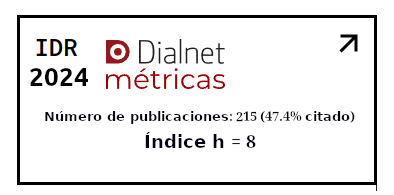Adult attachment profiles and personality characteristics in adolescents
Keywords:
Personality; affectivity; adolescence.Abstract
In the present study, the need to associate personality characteristics with the different adult attachment styles is raised. Despite the existence of numerous questionnaires to measure both adult attachment and personality characteristics, it has been chosen to choose two recent questionnaires, empirically validated and simple to administer, since the sample is made up of an indeterminate group of adolescents who were studying compulsory secondary education. The results show a high degree of correspondence between the four personality profile groups created through the CBP (Torreblanca, 2017) and the attachment styles used in the AAC (Melero and Cantero, 2008). Concordance is observed around 70% in three of the four profiles made with the attachment styles secure, worried and fearful. The remaining percentages in each group have been distributed heterogeneously. In the group corresponding to avoidant attachment, the concordance between personality profile and attachment style has been lower, giving rise to new research possibilities and the establishment of new hypotheses about adult attachment.
Downloads
References
Ainsworth, M. D. S. (1972). Attachment and dependency: A comparison. En J. L. Gewirtz (Ed.), Attachment and dependency. Washington, DC: Winston.
Allen, J. P., y Land, D. (1999). Attachment in adolescence. En J. Cassidy y P. Shaver. (Eds.), Handbook of Attachment: Theory, research, and clinical applications (pp. 223-319). Nueva York: The Guilford Press.
Bartholomew, K. (1990). Avoidance of intimacy: An attachment perspective. Journal of Social and Personal Relationships, 7, 147-178. https://doi.org/10.1177%2F0265407590072001
Bowlby, J. (1951). Maternal care and mental health. Ginebra: OMS. Recuperado de https://darkwing.uoregon.edu/~eherman/teaching/texts/Bowlby%20Maternal%20Care%20and%20Mental%20Health.pdf
Bowlby, J. (1973). Attachment and loss (vol. II, Separation). Londres: Hogarth Press. (ed), El apego y la pérdida (vol. II): La separación afectiva. Buenos Aires: Paidós 1993. Recuperado de http://www.paidopsiquiatria.cat/archivos/bowlby_vinculo_apego_perdida_07-09_m1.pdf
Bowlby, J. (1980). Attachment and loss (Vol. III): Loss, sadness and depression. London: Hogarth Press.
Brennan, K. A., y Shaver, P. R. (1995). Dimensions of adult attachment, affect regulation, and romantic relationship functioning. Personality and Social Psychology, 21(3), 267-283. https://doi.org/10.1177%2F0146167295213008
Cantero, M. J. (2003). Intervención temprana en el desarrollo afectivo. En A. Gómez, P. Viguer y M.J. Cantero (Coords), Intervención temprana: Desarrollo óptimo de 0 a 6 años, (pp.175-203). Madrid: Pirámide. Recuperado de https://dialnet.unirioja.es/servlet/libro?codigo=2996
Carrillo, S., Maldonado, C., Saldarriaga, L., Vega, L., y Díaz, S. (2004). Patrones de apego en familias de tres generaciones: abuela, madre adolescente, hijo. Revista Latinoamericana de Psicología, 36 (3), 409-430. Recuperado de https://www.redalyc.org/pdf/805/80536304.pdf
Cassidy, J., y Kobak, R. R. (1988). Avoidance and its relationship to other defensive processes. En J. Belsky y T. Nezworski (Eds.), Clinical implications of attachment (pp. 300-326). Hillsdale, NJ: Erlbaum.
Casullo, M. M., y Fernández Liporace, M. (2005). Los estilos de apego: Teoría y medición. Buenos Aires: JVE.
Collins, W. A., Gleason, T., y Sesma, A. J. (1997). Internalization, autonomy, and relationships: Development during adolescence. En J. E. Grusec y L. Kuczynski (Eds.), Parenting and children's internalization of values: A handbook of contemporary theory (pp. 78-99). New York: Wiley.
Collins, W. A., y Sroufe, L. A. (1999). Capacity for intimate relationships: A developmental construction. En W. Furman, B. B. Brown, y C. Feiring (Eds.), The development of romantic relationships in adolescence (pp. 125-147). Cambridge, UK: Cambridge University Press.
Erikson, EH (1968). Identidad: Juventud y crisis. Nueva York: Norton. https://doi.org/10.1002/bs.3830140209
Feeney, J., y Noller, P. (1990). Attachment style as a predictor of adult romantic relationships. Journal of Personality and Social Psychology, 28 (2), 281-291. Recuperado de https://pdfs.semanticscholar.org/bb95/29325a890c2f375d066dc544b8c6f3664f55.pdf
Hair, J. F., Anderson, R., Tatham, R., y Black, W. (1998). Multivariate data analysis. Upper Saddle River (New Jersey): Prentice Hall, Cop.
Horppu, R., y Ikonen-Varila, M. (2001). Are attachment stiles general interpersonal orientations?: Applicants´ perceptions and emotions in interaction with evaluators in a college entrance examination. Journal of Social and Personal Relationships, 18, 131-148. https://doi.org/10.1177%2F0265407501181006
IBM Corp. (2011). IBM SPSS Statistics para Windows, versión 20.0. Armonk, Nueva York: IBM Corp.
Kobak, R. R., y Sceery, A. (1988). Attachment in late adolescence: Working models, affect regulation and representation of self and other. Child Development, 59, 135-146. https://doi.org/10.2307/1130395
Larose, S., y Bernier, A. (2001). Social support process: Mediators of attachment state of mind and adjustment in late adolescence. Attachment and Human Development, 3, 96-120. https://doi.org/10.1080/14616730010024762
López, F. (1993). El apego a lo largo del ciclo vital. En M. J. Ortz y S. Yámoz (Eds). Teoría del apego y relaciones afectivas (pp. 11-62). Bilbao: Servicio Editorial de la Universidad del País Vasco. Recuperado de https://dialnet.unirioja.es/servlet/articulo?codigo=5531103
López, F. (2006). Apego: Estabilidad y cambio a lo largo del ciclo vital. Infancia y aprendizaje, 29 (1), 9-23. https://doi.org/10.1174/021037006775380830
López, F. (2015). Apego y relaciones amorosas. Información Psicológica, 82, 36-48. Recuperado de http://www.informaciopsicologica.info/OJSmottif/index.php/leonardo/article/view/382
Marrone, M. (2001). La teoría del Apego: Un enfoque actual. Madrid: Editorial Prismática. Recuperado de https://aperturas.org/articulo.php?articulo=0000198&a=La-teoria-del-apego-Un-enfoque-actual
Melero, R., y Cantero, M. J. (2008a). Los estilos afectivos en la población española: un cuestionario de evaluación del apego adulto. Clínica y Salud, 19(1), 83-100. Recuperado de https://journals.copmadrid.org/clysa/art/6c524f9d5d7027454a783c841250ba71
Melero, R., y Cantero, M. J. (2008b). Cuestionario de apego adulto: Evaluación en población española. Infocop, 40, 51-52. Recuperado de http://www.infocop.es/view_article.asp?id=2077&cat=38
Pastor, D. A., Barron, K. E., Miller, B. J., y Davis, S. L. (2007). A latent profile analysis of college students’ achievement goal orientation. Contemporary Educational Psychology, 32, 8-47. https://doi.org/10.1016/j.cedpsych.2006.10.003
Rodríguez, J. C. (2017). Apego e inteligencia emocional como predictores del funcionamiento familiar en familias en riesgo social (Tesis). Facultad de Ciencias de la Educación, Departamento de Psicología, Universidad de Almería. Recuperado de https://dialnet.unirioja.es/servlet/tesis?codigo=129849
Rodríguez-Góngora, J. (2015). Estilo educativo parental como valor predictivo del nivel de adaptación e Inteligencia Emocional de menores en riesgo social (Tesis). Facultad de Ciencias de la Educación, Enfermería y Fisioterapia, Departamento de Psicología, Universidad de Almería. Recuperado de https://dialnet.unirioja.es/servlet/tesis?codigo=132829
Rodríguez-Góngora, J., Pérez-Fuentes, M., y Gázquez, J. (2015). Relación entre el estilo educativo parental y el nivel de adaptación de menores en riesgo social. European Journal of Investigation in Health, Psychology and Education, 3(3), 301-318. https://doi.org/10.30552/ejihpe.v3i3.57
Rodríguez, J. C., y Rodríguez-Góngora, J. (2018). EntendiéndoTE: Programa de habilidades sociales y auto-reconocimiento y control de las emociones. Baue-Bassin (Mauricio): Editorial Académica Española.
Rosenstein, D. S., y Horowitz, H. A. (1996). Adolescent attachment and psychopathology. Journal of Consulting and Clinical Psychology, 64, 244-253. https://psycnet.apa.org/doi/10.1037/0022-006X.64.2.244
Sroufe, L. A. (1983). Infant-caregiver attachment and patterns of adaptation in preschool: The roots of maladaptation and competence. En M. Perlmutter (Ed.), The Minnesota Symposia on Child Psychology: Development and policy concerning children with special needs (pp. 16, 41-83). Hillsdale, NJ: Lawrence Erlbaum.
Torreblanca, L. (2017). Desarrollo de un nuevo instrumento de evaluación el cuestionario breve de personalidad (CBP) (Tesis doctoral). Universidad de Málaga, Málaga. Recuperado de https://riuma.uma.es/xmlui/bitstream/handle/10630/15686/TD_TORREBLANCA_MURILLO_Laura.pdf?sequence=1&isAllowed=y
Zimmermann, P. (2004). Attachment representations and characteristics of friendship relations during adolescence. Journal of Experimental Child Psychology, 88, 83-101. https://doi.org/10.1016/j.jecp.2004.02.002
Zimmermann, P., Maier, M. A., Winter, M., y Grossmann, K. E. (2001). Attachment and adolescent’s emotion regulation during a joint problem-solving task with a friend. International. Journal of Behavioral Development, 25, 331-343. Recuperado de https://psycnet.apa.org/record/2001-07249-005
Published
How to Cite
Issue
Section
License
Copyright (c) 2021 ACADEMO Revista de Investigación en Ciencias Sociales y Humanidades

This work is licensed under a Creative Commons Attribution 4.0 International License.







